Todos os dias oferecemos software com licenças GRATUITAS que do contrário você teria que comprar!
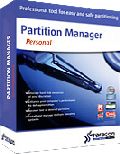
Giveaway of the day — Partition Manager 9.5 Personal (English)
Partition Manager 9.5 Personal (English) esteve disponível como oferta em 7 de abril de 2010
Use o original! As ferramentas avançadas de particionamento da Paragon Software ajudam você a controlar e gerenciar os seus discos rígidos.
Com o crescimento da capacidade dos hard drives, a necessidade de dividir o espaço de forma razoável é mais importante do que nunca. Esta ferramenta de particionamento fácil de usar é ideal para reestruturar o seu hard disk para um armazenamento eficiente e otimizado.
Funcionalidade completa:
- Conjunto completo de ferramentas de particionamento
- Suporte aos hardwares e softwares mais recentes
- Gerencimento de cópia, desfragmentação e boot
- Interface do usuário em dois níveis: Fácil e Avançado
- Mídia de recuperação em um suporte de CD/DVD/USB
Segurança nas operações críticas:
- A única solução com backup para recuperar dados perdidos
- Midia de Recuperação poderosa contra mal funcionamento do hardware ou falha do OS; 15 anos de experiência
- Tecnologia de Redimensionamento Paragon Hot Resize TM para aumentar partições sem fazer o boot do Windows
- Tecnologia Paragon Smart Partition TM para executar operações de particionamento com segurança
- Tecnologia Paragon Power Shield TM para fornecer dados consistentes
Suporte Técnico:
Durante o período de Giveaway a Paragon Software fornece suporte técnico em http://twitter.com/paragonsoftware. Por favor, poste as suas perguntas se você tiver problemas enquanto faz o download, registro ou uso do software. A equipe de suporte da Paragon entrará em contato assim que possível.
Requisitos do Sistema:
Windows 7/Vista/XP (32/64-bit); 300 MHz or higher; RAM 256 MB; Hard disk drive with 100 MB of available space; Internet Explorer 5.0 or higher; SVGA video adapter and monitor
Publicado por:
Paragon SoftwarePágina Oficial:
http://www.paragon-software.com/home/pm-personal/features.htmlTamanho do arquivo:
128 MB
Preço:
$39.95
Títulos em Destaque
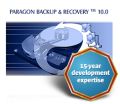
NOVO 10.1 Edition - Proteção Total ao PC para Usuários sérios! Tenha o controle completo da segurança do seu PC. Baseado em um sólido software de backup comercial e recuperação de sistema da Paragon, o novo Backup & Recovery 10.1 Free Edition lhe fornece um conjunto de recursos em quem você pode confiar. Pessoas imteligentes fazem backup; Backup & Recovery é um backup inteligente.
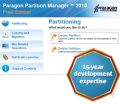
Particionamento não é para amadores. E é por isto que milhões de pessoas confiam em nossa estável e segura tecnologia e em nossas soluções profissionais há mais de 15 anos. O nosso mais recente Free 2010 Edition facilmente organiza o seu hard disk e redistribui o espaço livre para aumentar a performance do sistema.
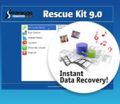
Não espere que um disastre aconteça - adquira um kit de recuperação instantânea de dados e sistemas que assegurem a sua proteção! O Rescue Kit conserta profissionalmente problemas de boot assim como recupera seus dados quando o seu sistema falha ao fazer o boot. Ele recupera até partições deletadas. Tudo o que você precisa fazer para ter controle total sobre qualquer situação é gravar o software no seu CD/DVD!
Comentáriosrios do Partition Manager 9.5 Personal (English)
Please add a comment explaining the reason behind your vote.
The Good
* Fairly easy to use - simple on-screen wizards to guide you through each task.
* Can create, expand, resize, merge, delete, undelete, copy, hide, unhide, rename (label and letter), and defrag partitions.
* Supports Windows, Linux, and Mac file system formats for partitions.
o Allows users to easily redistribute space between Windows and Mac partitions.
* Can copy a whole hard drive to another.
* Has error checking utilities.
* Allows users to perform image backups/restores.
o Can do selective restores and "restore partition with resize".
* Can create recovery media on CD/DVD/USB flash drive.
* Has handy MBR related features.
* Allows users to view partition contents of any file system while in Windows.
The Bad
* Huge download size.
* Doesn't support WinPE bootable media (Linux-based only).
* When formatting a partition, if partition size is small seeing which partition you have selected is difficult.
* Image backup size estimate is inconsistent and inaccurate.
* You can't copy a partition into an existing partition.
Free Alternatives
Paragon Partition Manager Free Edition
Partition Wizard
EASEUS Partition Manager Home Edition
For final verdict, recommendations, and full review please click here.
>> On January 11, 2010, we got Partition Manager 10 Personal already. So this is kind of a step backwards… Anyway, fine for new GOTD users.
It was the same build in January. We decided to give a chance to those who missed it to download it now. If you have a version from January, no need to download this one.
From now on our promo versions will have version number 0.5 lower than commercial version. So free version 9.5 is a clone of commercial version 10.
Paragon's software downloads are often large, but that's because of: 1) the bootable image file [you can put it on CD/DVD/USB device], & 2) the html-based help files...
Comparison with major alternatives: Acronis products are very good, but unless you grab the free, limited versions offered by some hard drive makers, like Seagate, they're expensive. The leading free alternative is GParted, which is a Linux app often put together with a small Linux OS setup so it can be run from CD/DVD/USB. Norton Partition Mgr. was once not only the standard, but the only widely available, well known Windows partitioning app. Norton used that as an excuse to over-price Partition Mgr. [IMHO], & slow the development of new, better features & compatibility. For quite a few years now the only times I see the Norton name it's either a complaint, or talking about the company's habits of producing very incompatible bloat-ware. That said, you can sometimes pick up OEM discs [designed for distro with new PCs/laptops] very cheap. EASEUS makes excellent partitioning software, & is well known because of prior Giveaways. Their main disadvantages vs. Paragon is more limited help & support, & their backup solution, while it does work, doesn't measure up [to much of anything IMHO].
In actual use the final results are not going to be much different no matter which partitioning software you use [assuming it works], so Paragon outshines the competition with value added features. I use both EASEUS & Paragon for partitioning because Paragon adjusts your PC to account for partition changes, & I don't always want/need that.
Example: I had a system crash that rendered a file unreadable. Windows' disc check found it & marked a sector of the hard drive as bad [don't know if it is/was or not, but I suspect not], which the NTFS file system remembers -- forever -- & it causes problems with some partitioning &/or defragging programs. You can replace the drive, or maybe use drive utilities to fix the original problem, like I did, but to wipe the error from NTFS *memory* meant *copying* the partition to a new one & back -- cloning &/or backups include NTFS *memories* of any/all bad sectors. [Imagine replacing a drive to find the new one has hundreds of **reported** bad sectors -- it happens] For that operation I used EASEUS, because I didn't want or need to mark that temporary partition as bootable -- if I had I would have used Paragon & it would have worked that way automagically.
The payware versions of Paragon's apps often include a limited, Windows-like environment you can boot to when/as needed [WinPE]. The main advantage is moving a lot of files around is faster than using the *usual* [& free] Linux boot environ that often comes with disc-related apps. A faster bootable *nix setup rather than mini-versions, &/or a mini Windows environ [I use LiveXP] can make a world of difference when restoring a backup [or use another PC/laptop, remove your drive & use an inexpensive dock]. For partitioning, unless you're copying your boot partition, just not much call or reason for it -- since CD/DVD/USB transfer is slower that your SATA hard drive(s), *might* even take longer using those bootable devices.
Partitioning -- briefly how/why...
Hard drives -- & devices that mimic hard drives, like USB sticks -- have at least 1 partition... in order to have a Table Of Contents & manage the storage space something has to keep track of how much space there is. And if you think of a hard drive as a 3 ring binder, adding partitions is just like adding those tabbed page dividers, & for the same sorts of reasons. Taking it a step further, you might use 1 binder & however many dividers, or simply use more than one binder; doesn't matter or change the pages inside the binders what-so-ever -- but it does effect how many pages you can have, how easy it is to find what you're after, & of course you have to put the binders somewhere -- the more you have the more space they take up.
Since Windows cares about the pages -- not the binders -- having one or several partitions &/or drives generally makes no difference to it at all. It does however matter to your PC... you can only physically fit so many drives in a case [or on your desk if you're talking external], & at some point it'll become a problem connecting just one more. And it matters to your Operating Systems, from the standpoint that different OSes & versions just don't get along. If you want to be able to boot into more than 1 version of Windows, having each version on it's own partition [whether on the same drive or not doesn't matter], means different versions of the same files can co-exist in folders with the same name. That's it. [Vista & 7 have a *fake* docs & settings folder, but in XP it's very much real -- doesn't take much imagination to see potential problems there. ;-) ] Linux normally uses a different file system entirely, so a partition or drive has to be formatted in a way that Windows *out-of-the-box* doesn't understand.
What can adding partitions do for you?... Besides maybe better, easier organization, it's faster/easier to maintain a smaller amount of drive space than a large one. If your music, photo, &/or video collections don't change as often as your software &/or Windows, do you need to scan them for viruses, defrag, or back them up as often? Probably not. OTOH do you want to spend more time than necessary when you perform those tasks re: windows & your software? Again, probably not.
Now, you add a partition to a hard drive when it's installed or connected, before it can be formatted & used. Dividing that original partition into smaller pieces is normally a 2 step affair -- you make the existing partition smaller, then create a new one in the left over hard drive space [Paragon's Partition Mgr & other apps will say it's unallocated]. It's common sense that defragging the drive, to move all your files to the beginning of the partition, gives you more free space at the end you're going to basically chop off. While you should still back everything up [**** does happen], working with partitions this way is almost trivial.
Your PC/laptop needs 1 drive designated as the boot drive, and there's a small amount of code that needs to be at the front of that drive [Paragon's Partition Mgr can handle that], but in Windows since XP, you can re-order hard drives & partitions as you wish. There's much less reason to create a new partition at the beginning of an existing partition rather than the end with all the free space, which is where partitioning could go wrong in the past, moving all that data. Still, if you need to, nowadays you can [fairly] easily move all the files on or in partitions around as if they were a single folder. You do that by restoring a disc image backup wherever you need it, to whichever partition you want it on, or by copying the partition from one place to another. The main practical difference between the two is copying recreates the NTFS tables on the partition, & doesn't leave you with a permanent archive of the partition's contents the way creating a backup image does. When you copy or restore a partition image sometimes the destination isn't the same size as the original -- while you have to have enough room for the files you're moving, you can sometimes end up with unallocated space at the end of your destination partition -- if the software doesn't adjust that automatically, it's easy to then just *grow* the partition to take up the rest of the space. If you find you can't copy or restore a partition to an existing partition [different apps have different restrictions], just delete it, & copy/restore to the now unallocated space.
Just in case...
When you're moving partitions & their contents, you can have hardware &/or software errors &/or failures, lose power etc... Create a disc image backup, & Don't store it on the drive you're working on if at all possible. Make an image backup of the boot drive's MBR tables -- I use Paragon's software -- which you might well need if you have to put everything back the way it was. It can also help to have a copy of NeoSmart's free Easy BCD -- read the docs & have the associated boot files handy -- which can work with XP as well as Vista & 7. Day to day running Windows you're probably not accessing most every bit of your hard drive(s), & realistically there could be a problem waiting for you that you just haven't come across yet. There may be part of a drive you can't access, &/or maybe it's been loafing, goofing off just reading/writing the contents of your browser cache for a while. You're about to make it run a marathon.
On January 11, 2010, we got Partition Manager 10 Personal already. So this is kind of a step backwards... Anyway, fine for new GOTD users.
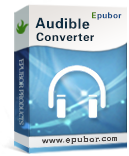

Os programas do GAOTD estão deixando muito a desejar. Ou não funcionam, como o de ontem, ou são mastodontes como esse Partition Manager. Muito grande para fazer pouca coisa.
Save | Cancel